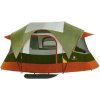I do not understand rain fly's that only cover the top of the tent.
I recently bought a nice, large (car camping) tent made by Swiss Gear from someone on craigslist. If you search "Swiss Gear Valais" on amazon, you'll see it.
I like it a lot but I'm just confused by tents that have, what seems to me, a partial rain fly. I feel like any really good or long rain event, let alone with wind(!) is basically going to put the tent walls to the test as your rain barrier.
I feel like this tent needs another rain fly or some protection from the rain if it's at all in the forecast. What's the deal?
I recently bought a nice, large (car camping) tent made by Swiss Gear from someone on craigslist. If you search "Swiss Gear Valais" on amazon, you'll see it.
I like it a lot but I'm just confused by tents that have, what seems to me, a partial rain fly. I feel like any really good or long rain event, let alone with wind(!) is basically going to put the tent walls to the test as your rain barrier.
I feel like this tent needs another rain fly or some protection from the rain if it's at all in the forecast. What's the deal?
Attachments
-
10.9 KB Views: 7



